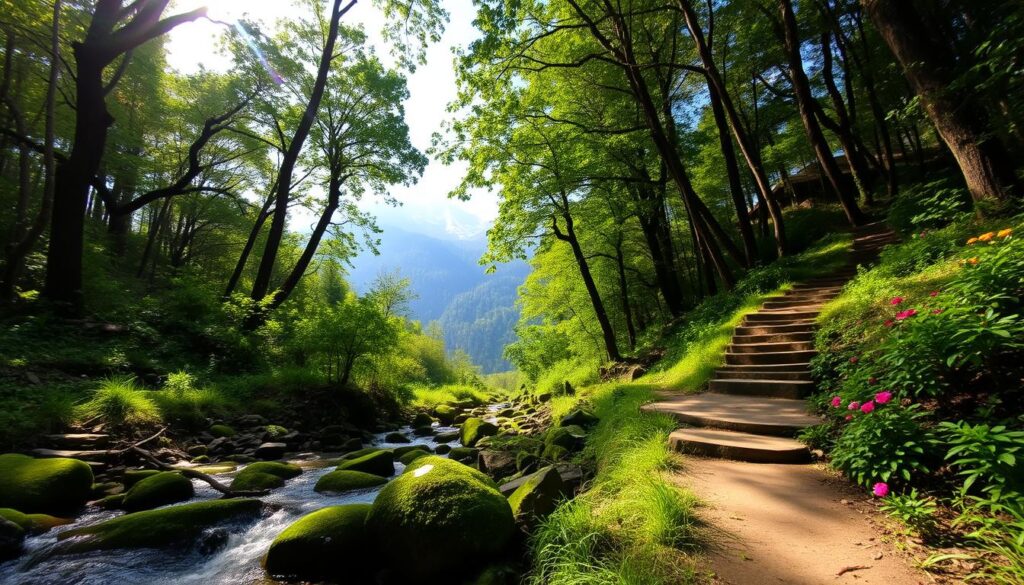Nestled in the serene hills of Mussoorie, Benog Wildlife Sanctuary is a haven for nature lovers and adventure seekers. As you step into this natural paradise, you’ll be surrounded by dense forests, crystal-clear streams, and majestic mountains.
This sanctuary is home to a diverse range of flora and fauna, making it an ideal destination for wildlife enthusiasts and photographers. With its unique mix of peacefulness and natural beauty, Benog Wildlife Sanctuary is the perfect spot to escape the hustle and bustle of daily life and immerse yourself in nature.
Key Takeaways
- Experience the serene environment of Benog Wildlife Sanctuary.
- Explore the diverse range of flora and fauna.
- Capture stunning photos in the sanctuary’s natural beauty.
- Escape the hustle and bustle of daily life.
- Immerse yourself in nature’s tranquility.
The Natural Paradise of Uttarakhand
Your trip to Benog Wildlife Sanctuary in Mussoorie, Uttarakhand, is unforgettable. You’ll find lush forests and diverse wildlife. It’s perfect for those wanting to get away from city life and enjoy nature’s peace.
Geographic Location and Accessibility
The Benog Wildlife Sanctuary is in Mussoorie, a beautiful hill station in Uttarakhand. It’s easy to reach by road. The closest airport is Jolly Grant Airport in Dehradun, about 60 km away. Dehradun Railway Station, connected to major cities, is the nearest railway station.
Getting There: You can reach the sanctuary by road, air, or train. The trip is exciting, with stunning views and landscapes.
Historical Significance of the Region
The area around Benog Wildlife Sanctuary is not just beautiful but also has a rich history. Mussoorie’s history and culture add to the sanctuary’s charm. The region has seen efforts to protect its natural beauty and biodiversity.
Conservation Efforts: The sanctuary shows the region’s commitment to nature. It’s a safe home for many plants and animals. It symbolizes the dedication to preserving nature for the future.
Essential Guide to Benog Wildlife Sanctuary
Your adventure at Benog Wildlife Sanctuary starts with knowing the entry fee, ticket price, and timings. It’s important to be aware of these details for a smooth and enjoyable visit.
Benog Wildlife Sanctuary Entry Fee and Ticket Price
The Benog Wildlife Sanctuary entry fee is low, making it affordable for families and travelers. The ticket price is set to be budget-friendly. This encourages more people to see the natural beauty and wildlife of the sanctuary.
| Category | Entry Fee |
|---|---|
| Indian Nationals | ₹50 |
| Foreign Tourists | ₹200 |
| Children Below 5 Years | Free |
Benog Wildlife Sanctuary Timings and Best Hours
The sanctuary is open from sunrise to sunset. This lets visitors explore at their own pace. The best time is early morning or late afternoon when wildlife is most active.
To enjoy your visit fully, plan your day well. The Benog Wildlife Sanctuary timings match the wildlife’s natural habits. This makes your experience more engaging.
Why Visit Benog Wildlife Sanctuary
Discover the untouched beauty of Benog Wildlife Sanctuary. It’s a haven for nature lovers and adventure seekers. Located in the heart of the Himalayas, it’s more than a place to visit. It’s an experience that reconnects you with nature.
Ecological Importance in the Himalayan Ecosystem
Benog Wildlife Sanctuary is key to the Himalayan ecosystem’s balance. It’s a vital home for many plants and animals, some found only here. The sanctuary’s forests help control the climate, keep soil quality, and support water cycles.
The sanctuary’s ecological value is clear in its:
| Ecological Feature | Description | Impact |
|---|---|---|
| Biodiversity | Home to a wide variety of plants and animals | Supports ecosystem services |
| Forest Cover | Dense forests that regulate climate and soil | Maintains ecological balance |
| Water Cycles | Supports local water sources | Essential for local communities |
Unique Visitor Experiences
Your visit to Benog Wildlife Sanctuary is more than just wildlife watching. It’s about diving into a unique ecosystem. You can enjoy guided wildlife safaris, nature trails, and birdwatching to explore the area’s rich biodiversity.
“The real voyage of discovery consists not in seeking new landscapes, but in having new eyes.” – Marcel Proust
Visitors can enjoy:
- Guided tours led by experienced naturalists
- Nature trails that wind through the sanctuary’s diverse landscapes
- Birdwatching sessions to spot rare avian species
Exploring the sanctuary lets you see the Himalayas’ majestic beauty up close. Remember your camera to capture the stunning views and wildlife.
Best Time to Visit Benog Wildlife Sanctuary
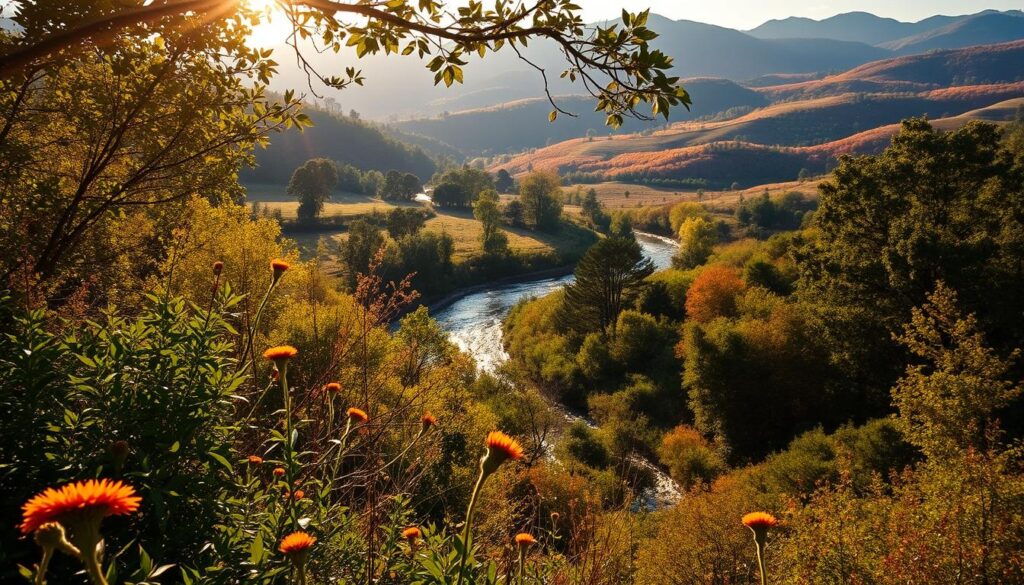
Find out the best time to visit Benog Wildlife Sanctuary for a great wildlife adventure. It’s located in the heart of Uttarakhand. The seasons offer different experiences.
Seasonal Weather Patterns
Benog Wildlife Sanctuary has a subtropical climate. Winters are mild, and summers are cool. Spring, from March to June, is perfect for outdoor fun.
Autumn, from September to November, is also great. The weather is comfortable, and the scenery is beautiful. Winters are chilly, and summers are mild, making it peaceful for wildlife lovers.
Wildlife Viewing Opportunities by Season
The spring and autumn seasons are best for wildlife watching. You can see deer, leopards, and many birds.
In spring, the greenery is lush, and animals feel at home. Autumn’s clear skies help spot wildlife. Summer is great for birdwatching, as birds are more active.
| Season | Weather | Wildlife Viewing |
|---|---|---|
| Spring (March to June) | Pleasant, 15°C to 25°C | Ideal for spotting deer and leopards |
| Autumn (September to November) | Comfortable temperatures, vibrant foliage | Optimal for wildlife viewing |
| Summer | Mild | Good for birdwatching |
Festival and Event Calendar
Benog Wildlife Sanctuary has many festivals and events all year. Dates change, but there’s always something to enjoy. You can join cultural events and learn about wildlife conservation.
“The best way to get to know nature is to spend time in it. Benog Wildlife Sanctuary is a haven for those seeking to reconnect with the natural world.”
Looking at the local event calendar before you go can make your visit better. You can join in on the fun and learn more about the sanctuary.
Flora and Fauna Highlights
Discover the rich biodiversity of Benog Wildlife Sanctuary, where diverse flora and fauna thrive. It’s a haven for nature enthusiasts and wildlife lovers. Here, you can explore the natural beauty of the Himalayan region.
Iconic Wildlife Species
The Benog Wildlife Sanctuary is home to many iconic wildlife species. You can see the majestic Himalayan monal, the agile barking deer, and the sturdy Himalayan goats. These species are a delight to observe and play a key role in the sanctuary’s ecosystem.
- Himalayan Monal: Known for its vibrant plumage, the Himalayan monal is a sight to behold.
- Barking Deer: With its distinctive call, the barking deer adds to the sanctuary’s charm.
- Himalayan Goats: These goats are well adapted to the rugged terrain of the sanctuary.
Notable Plant Life and Vegetation
The sanctuary boasts an impressive array of notable plant life and vegetation. You’ll find dense forests, grasslands, and a variety of plant species. The vegetation is not only beautiful but also provides a vital habitat for the wildlife.
| Plant Species | Description |
|---|---|
| Oak Trees | Dominant in the sanctuary, oak trees provide shelter and food for various wildlife. |
| Pine Trees | Common in the higher altitudes, pine trees add to the sanctuary’s biodiversity. |
| Medicinal Herbs | The sanctuary is home to a variety of medicinal herbs, used in traditional medicine. |
Exploring the Benog Wildlife Sanctuary is a treat for the eyes. You’ll see the incredible diversity of flora and fauna that live here. Whether you love nature, wildlife, or just need a peaceful escape, the sanctuary has something for everyone.
Things to Do at Benog Wildlife Sanctuary
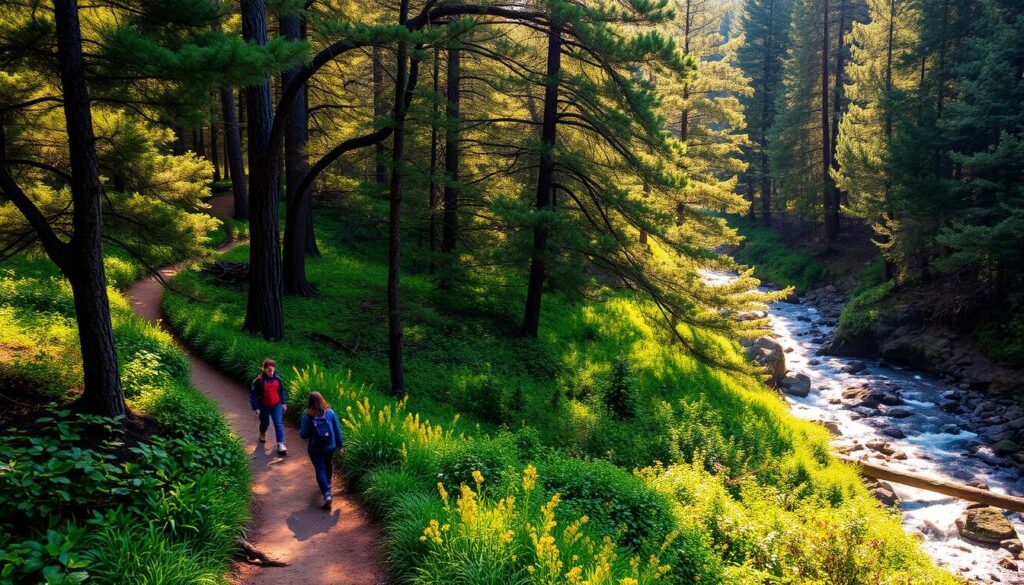
Your adventure at Benog Wildlife Sanctuary is more than just seeing wildlife. It’s a full experience with nature trails, bird watching, and peaceful spots for meditation. The sanctuary has many activities for all interests, making your visit unforgettable and enriching.
Nature Trails and Hiking Routes
Benog Wildlife Sanctuary has many nature trails and hiking routes. These paths let you see the Himalayan ecosystem up close. The Benog Tibba trail is a highlight, with stunning views of mountains and valleys.
As you hike through the forests, you’ll see many plants and animals. Every step is a new discovery.
Bird Watching Hotspots
For bird lovers, Benog Wildlife Sanctuary is a dream come true. It’s home to many bird species, perfect for bird watching. Look out for the Himalayan Monal, pheasants, and eagles as you walk the trails.
The sanctuary’s varied habitats support a rich bird life. Your bird watching will be both rewarding and memorable.
Meditation and Yoga Spots
Beyond its natural beauty and wildlife, Benog Wildlife Sanctuary has peaceful spots for meditation and yoga. The calm surroundings and fresh mountain air are perfect for relaxation. Find a quiet spot among the trees and let nature calm your mind and body.
Capturing Benog Wildlife Sanctuary Photos
Every moment at Benog Wildlife Sanctuary is a chance to take a great photo. The place is full of different landscapes and animals. It’s perfect for photographers to practice their skills.
Best Photography Locations
Benog Wildlife Sanctuary has many great spots for photos. The Benog Tibba viewpoint is a favorite, with amazing views. You’ll also find beautiful forests and lots of plants and animals.
Top Photography Spots:
- Benog Tibba viewpoint
- Forest trails
- Wildlife watering holes
Each spot offers a unique setting to capture the sanctuary’s beauty.
Photography Tips and Techniques
Here are some tips to enhance your photography at Benog Wildlife Sanctuary:
| Tip | Description |
|---|---|
| Golden Hour | Shoot during the golden hour, early morning or late afternoon, for beautiful light. |
| Be Patient | Wait for the perfect shot. Wildlife photography takes patience. |
| Respect Wildlife | Keep a safe distance and don’t disturb the animals. It’s good for your safety and theirs. |
By using these tips and exploring the sanctuary, you’ll capture its essence.
Benog Wildlife Sanctuary Tours and Guides
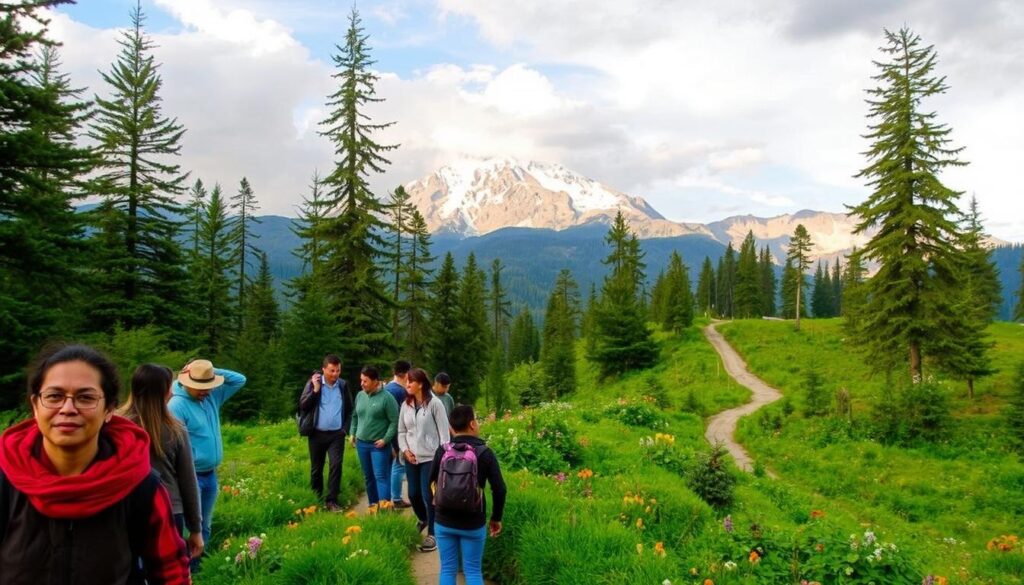
There are many tour options to pick from, so you can find the one that fits you best. Benog Wildlife Sanctuary has tours for all kinds of interests. This ensures a memorable visit.
Expert-Led Sanctuary Tours
The sanctuary offers official guided tours by knowledgeable guides. They know a lot about the local wildlife and ecosystem. These guides share interesting facts about the animals and their homes.
By joining an official tour, you learn more about the sanctuary’s role in nature. You also see the work done to protect it.
Customized Private Tours
If you want something special, private tour operators can create tours just for you. Whether you love birds, photography, or just nature, they can make it happen. Private tours are all about you.
These tours let you go at your own speed. You get expert help and support as you explore.
Exploring on Your Own
For those who like to do things their way, self-guided tour options are perfect. The sanctuary has trails and signs to help you wander. You can see its wonders at your own pace.
Self-guided tours give you freedom. You can stop whenever you want, take photos, and enjoy the views. It’s all about your own schedule.
| Tour Type | Description | Duration |
|---|---|---|
| Official Guided Tour | Led by experienced guides, providing insights into wildlife and ecosystem. | 2-3 hours |
| Private Customized Tour | Tailored to specific interests, offering a personalized experience. | Variable |
| Self-Guided Tour | Independent exploration with the aid of trails and signage. | Variable |
No matter your choice, Benog Wildlife Sanctuary offers a unique experience. It’s a chance to connect with nature in a special way.
Practical Information for Visitors
Planning your trip to Benog Wildlife Sanctuary? You’ll want to know the practical details for a smooth visit. Understanding the logistics will make your journey enjoyable and stress-free.
How to Reach Benog Wildlife Sanctuary
Getting to Benog Wildlife Sanctuary is easy by road, air, or train. The nearest airport is in Dehradun, with connections to major cities. If you’re coming by train, Dehradun’s station is your closest stop. From there, you can take a taxi or bus to the sanctuary.
Traveling by road? The sanctuary is 8 km from Mussoorie. The drive from Dehradun or Mussoorie offers stunning Himalayan views, perfect for your wildlife adventure.
Accommodation Options
Benog Wildlife Sanctuary has something for everyone, from luxury resorts to budget-friendly lodges and campsites. You can stay in Mussoorie or nearby, making it easy to access the sanctuary.
Here are some top picks:
- Hotels in Mussoorie with amazing views
- Eco-lodges for a nature-rich stay
- Campsites for a wilderness experience
What to Pack and Prepare
Right gear is key for a great visit to Benog Wildlife Sanctuary. Here’s what to pack:
- Comfortable clothes and sturdy shoes for hiking
- Layers for changing weather
- Binoculars for wildlife watching
- Camera and charger for photos
- Reusable water bottle to stay hydrated
- Snacks and energy bars for quick energy
Check the weather forecast before you go. Being prepared will make your visit better and let you enjoy the sanctuary’s beauty.
Safety Tips and Travel Advice
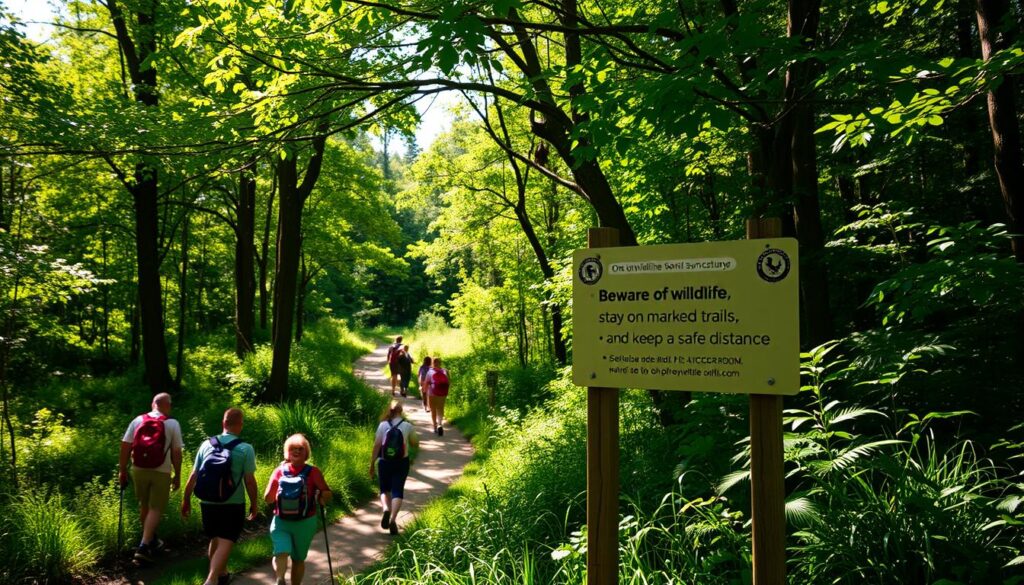
Your adventure in Benog Wildlife Sanctuary can be both thrilling and safe if you follow the right safety tips. It’s important to know how to interact with wildlife and be ready for emergencies.
Wildlife Interaction Guidelines
When exploring the Benog Wildlife Sanctuary, it’s crucial to keep a safe distance from animals. Keeping a safe distance protects you and the wildlife. Here are some key guidelines to follow:
- Never attempt to feed or touch the wildlife.
- Stay on designated trails to avoid encounters with wild animals.
- Be aware of your surroundings and keep an eye out for any wildlife.
Understanding these guidelines can make your experience better. For example, knowing how to react during a wildlife encounter is crucial. Remaining calm and following the guide’s instructions is key to a safe interaction.
Health and Emergency Preparedness
Being prepared for health and emergencies is vital when visiting Benog Wildlife Sanctuary. Here are some tips to ensure you’re ready:
| Preparation | Description |
|---|---|
| First-Aid Kit | Carry a basic first-aid kit that includes band-aids, antiseptic wipes, and any personal medications. |
| Emergency Contacts | Save the emergency contact numbers, including the sanctuary’s administration and local emergency services. |
| Weather Awareness | Stay informed about the weather forecast to avoid being caught in adverse conditions. |
It’s also a good idea to inform someone about your itinerary and expected return time. This ensures that if something goes wrong, help can be sent your way promptly.
By following these safety tips and being prepared, you can enjoy a safe and memorable visit to Benog Wildlife Sanctuary. Your adventure awaits, and with the right precautions, you’ll be free to explore and cherish the natural beauty of this incredible destination.
Nearby Attractions and Day Trips
The area around Benog Wildlife Sanctuary is full of natural wonders and cultural sites. Your adventure doesn’t have to stop when you leave the sanctuary. It can be the start of exploring Uttarakhand’s rich heritage.
Natural Landmarks Within 50km
Close to Benog Wildlife Sanctuary, you’ll find Kempty Falls. It’s a beautiful waterfall perfect for a day trip. The area is lush and great for picnics and walks.
Another spot to visit is Lal Tibba. It’s a scenic viewpoint with stunning views of the Himalayas.
Cultural Sites and Local Experiences
The area around Benog is rich in culture and history. You can see local temples and monasteries, like the Dhakrani Mahadev Temple. It’s known for its unique architecture and spiritual importance.
Exploring local markets also offers a peek into traditional crafts and lifestyle.
Some top day trip recommendations include:
- Visiting Kempty Falls for a picnic and some adventure
- Exploring Lal Tibba for panoramic views of the Himalayas
- Discovering local temples and monasteries to experience the spiritual side of the region
- Shopping at local markets for traditional handicrafts
These experiences will deepen your understanding of local culture. They will also make your trip to Benog Wildlife Sanctuary unforgettable.
Conclusion: Preserving the Natural Heritage
Exploring the Benog Wildlife Sanctuary is more than just seeing nature’s beauty. It’s also helping with important conservation work. This place is a big win for saving nature for the future.
Your visit can really help. By being careful and respecting nature, you help keep this special place safe. The Benog Wildlife Sanctuary is a treasure for those who love nature and adventure. Saving it is something we all need to do together.
When you plan your visit, remember the importance of saving nature. Help local efforts and follow the rules to leave a small mark. Together, we can keep the Benog Wildlife Sanctuary a vibrant, diverse, and beautiful place.
FAQ
Q: Where is Benog Wildlife Sanctuary located?
A: Benog Wildlife Sanctuary is in the beautiful town of Mussoorie, Uttarakhand.
Q: How do I reach Benog Wildlife Sanctuary?
A: You can reach the sanctuary by road. The closest airport is Jolly Grant Airport in Dehradun, about 60 km away. Dehradun Railway Station is the nearest railway station and is well-connected to major cities.
Q: What are the Benog Wildlife Sanctuary timings?
A: The sanctuary is open from sunrise to sunset. This allows visitors to explore at their own pace.
Q: What is the Benog Wildlife Sanctuary entry fee?
A: The entry fee is very low. This makes it a great choice for families and travelers.
Q: What is the best time to visit Benog Wildlife Sanctuary?
A: Spring and autumn are the best times to visit. The weather is nice, and wildlife viewing is great.
Q: What activities can I do at Benog Wildlife Sanctuary?
A: You can enjoy guided wildlife safaris, nature trails, birdwatching, and meditation and yoga.
Q: Are there guided tours available at Benog Wildlife Sanctuary?
A: Yes, there are official guided tours. Experienced guides will share insights into the wildlife and ecosystem. Private tour operators also offer customized tours.
Q: What are the accommodation options near Benog Wildlife Sanctuary?
A: There are many places to stay, including hotels, lodges, and campsites. You can find something that fits your budget and preferences.
Q: What are the safety guidelines for interacting with wildlife at Benog Wildlife Sanctuary?
A: Keep a safe distance, don’t feed the animals, and stay aware of your surroundings. This ensures a safe and fun visit.
Q: Are there any nearby attractions to Benog Wildlife Sanctuary?
A: Yes, there are many natural and cultural attractions nearby. You can visit Kempty Falls, Lal Tibba, temples, monasteries, and local markets.
Q: Can I do photography at Benog Wildlife Sanctuary?
A: Yes, it’s a great place for photography. You can take amazing photos of the Himalayas, forests, and wildlife.
Read More Articles;
- Kaas Plateau Travel Guide 2026: Best Time to Visit, Bloom Season, How to Reach & FAQs
- What Is the Quirimbas Archipelago Mozambique Known For? Complete Travel & Nature Guide
- Is Angola Safe to Travel in 2025? Your Essential Guide to Health, Crime, and Landmine Safety
- What Animals Live in Bale Mountains Ethiopia? Complete Wildlife Guide
- What to Do in Damaraland — Complete Travel Guide for First-Timers

